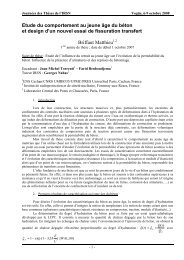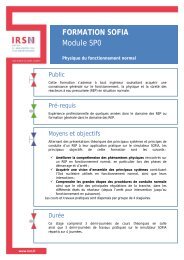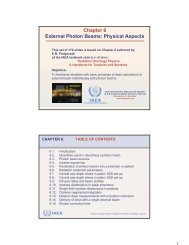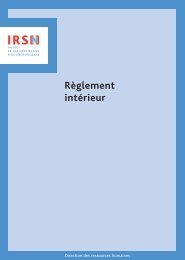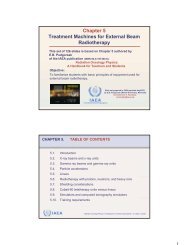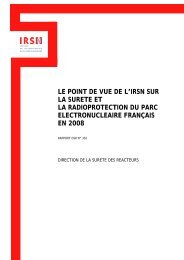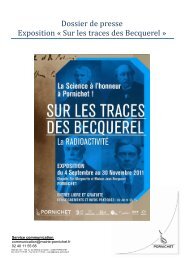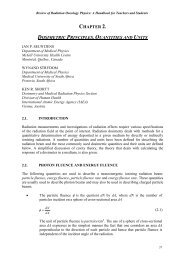Review of Radiation Therapy Physics: A syllabus for teachers ... - IRSN
Review of Radiation Therapy Physics: A syllabus for teachers ... - IRSN
Review of Radiation Therapy Physics: A syllabus for teachers ... - IRSN
You also want an ePaper? Increase the reach of your titles
YUMPU automatically turns print PDFs into web optimized ePapers that Google loves.
Chapter 11. Computerized Treatment Planning Systems <strong>for</strong> External Beam radiotherapy• Commissioning tests will include geometry with oblique fields, and fields usingasymmetrical jaws. Beam junctioning as calculated by the TP system, <strong>for</strong> eitherabutting fields or those junctioned with independent jaws, can be compared to testcases measured with film or detector arrays.• Calculations <strong>of</strong> rotational beams <strong>for</strong> both photons and electrons can be comparedto measured or published data. Special attention must be given to the beamweighting and normalization used <strong>for</strong> rotational and arced beams.• To confirm file compatibility between the CT-scanner and the treatment planningsystem, a file transfer process must be per<strong>for</strong>med. Computerized tomographyusing helical scans may require separate transfer s<strong>of</strong>tware.• The transfer <strong>of</strong> image data is checked by per<strong>for</strong>ming analysis <strong>of</strong> the input data <strong>for</strong>a known configuration and density such as a phantom to detect any error inmagnification and in spatial coordinates. Special attention should be given topixel values, scan size and matrix size. The images must be checked <strong>for</strong> theintegrity <strong>of</strong> surface rendering especially <strong>for</strong> unlinked structures like arms.• The large amount <strong>of</strong> data used by a TP system can make routine verification <strong>of</strong> alldata difficult or impossible. Scheduled checks <strong>of</strong> dose distributions and beamtime/MUcalculations using a standard geometrical phantom with a variety <strong>of</strong>fields and beam modifiers are recommended on all TP system, and the frequencyand scope <strong>of</strong> these procedures are described in the references. The use <strong>of</strong>checksum programmes can ensure file and data integrity, and alert the user to thepossibility <strong>of</strong> inadvertent data changes or file corruption.11.5.3. Spot checksSpot checks <strong>of</strong> measured data versus those obtained from the TP system are required, andthese spot checks can also involve calculations <strong>of</strong> fields shielded by blocks or MLC. Spotchecks <strong>of</strong> static and dynamic wedged fields with respect to measured data points are alsorecommended. A detector array may be used to verify wedged, and even more importantly,dynamically wedged dose distributions produced by the TP system. Wedge distributionsproduced by the TP system must be verified <strong>for</strong> identification, orientation, beam hardening,and field size limitations.11.5.4. Normalization and beam weightingDose normalization and beam weighting options vary from one TP system to another andhave a direct impact on the representation <strong>of</strong> patient dose distributions. Normalization may bereferred to: (i) a specific point such as the isocenter or to (ii) the intersection <strong>of</strong> several beamaxes, or to (iii) a minimum or maximum value in a slice or entire volume. Normalization canbe to an arbitrary isodose line in a volume, or to a minimum or maximum isosurface, orrelated to a target or organ. Beam weighting may depend on whether the technique is SSD orSAD.• Common TP system weighting <strong>for</strong> SSD set-ups relate the 100% value to the givendose at the depth <strong>of</strong> dose maximum per beam.330



